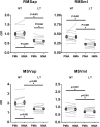Fingertip-Coupled Spindle Signaling Does Not Contribute to Reduce Postural Sway Under Light Touch
- PMID: 31507441
- PMCID: PMC6713998
- DOI: 10.3389/fphys.2019.01072
Fingertip-Coupled Spindle Signaling Does Not Contribute to Reduce Postural Sway Under Light Touch
Abstract
The details of how light touch (LT) of a stable surface reduces postural sway are still not well known. We hypothesized that removal of feedback provided by muscle afferents of the touching fingertip would increase postural sway in standing subjects. Eleven participants stood upright on a force plate with eyes closed and on an unstable surface. The experimental conditions involved two different finger positions: with partial muscle afferents (PMA), which includes sensory information from the fingertip flexor muscles, and no muscle afferents (NMA), without information from either fingertip flexor or extensor muscles. In the control condition, the participants kept the same posture, but with no finger touch (NT). Postural sway in both anteroposterior (AP) and mediolateral (ML) axes were recorded. Results showed that LT decreased all sway quantifiers as compared with the NT condition. The withdrawal of information from the touch finger muscle afferents (NMA condition) did not increase postural sway. Actually, there was a small, albeit statistically significant, decrease in the variability of center of pressure displacement in the AP direction. These results indicate that in some cases, muscle afferent input may either not contribute or even worsen the overall quality of sensory feedback from a given body segment, leading to no improvement or even a slightly decreased performance of the motor control system (evaluated by means of levels of postural sway in the present investigation). The results suggest that non-spindle fingertip afferents provide the bulk of the sensory feedback associated with the fingertip that is touching a ground-referenced object during quiet standing under LT.
Keywords: balance; center of pressure; fingertip touch; haptic information; muscle spindles; postural control.
Figures




Similar articles
-
Reduced postural sway during quiet standing by light touch is due to finger tactile feedback but not mechanical support.Exp Brain Res. 2008 Jun;188(1):153-8. doi: 10.1007/s00221-008-1426-5. Epub 2008 May 28. Exp Brain Res. 2008. PMID: 18506433
-
Additional Haptic Information Provided by Anchors Reduces Postural Sway in Young Adults Less Than Does Light Touch.Front Neurosci. 2018 Jun 5;12:346. doi: 10.3389/fnins.2018.00346. eCollection 2018. Front Neurosci. 2018. PMID: 29922122 Free PMC article.
-
A light fingertip touch reduces postural sway in children with autism spectrum disorders.Gait Posture. 2016 Jan;43:137-40. doi: 10.1016/j.gaitpost.2015.09.012. Epub 2015 Sep 25. Gait Posture. 2016. PMID: 26422366
-
Light touch for balance: influence of a time-varying external driving signal.Philos Trans R Soc Lond B Biol Sci. 2011 Nov 12;366(1581):3133-41. doi: 10.1098/rstb.2011.0169. Philos Trans R Soc Lond B Biol Sci. 2011. PMID: 21969695 Free PMC article. Review.
-
The Importance of Being in Touch.Front Neurol. 2021 May 14;12:646640. doi: 10.3389/fneur.2021.646640. eCollection 2021. Front Neurol. 2021. PMID: 34054694 Free PMC article. Review.
Cited by
-
Specific Posture-Stabilising Effects of Vision and Touch Are Revealed by Distinct Changes of Body Oscillation Frequencies.Front Neurol. 2021 Nov 22;12:756984. doi: 10.3389/fneur.2021.756984. eCollection 2021. Front Neurol. 2021. PMID: 34880823 Free PMC article.
-
Transcutaneous spinal direct current stimulation (tsDCS) does not affect postural sway of young and healthy subjects during quiet upright standing.PLoS One. 2022 Apr 28;17(4):e0267718. doi: 10.1371/journal.pone.0267718. eCollection 2022. PLoS One. 2022. PMID: 35482798 Free PMC article.
References
LinkOut - more resources
Full Text Sources
Research Materials

